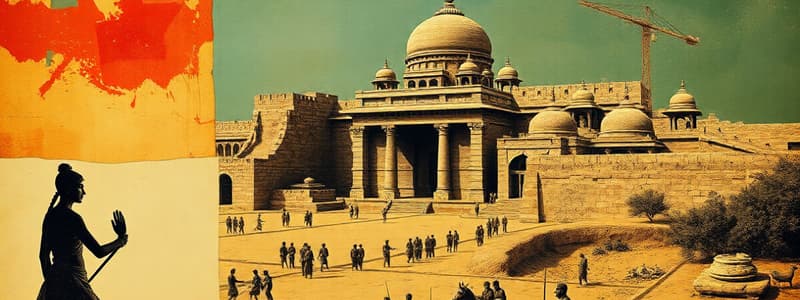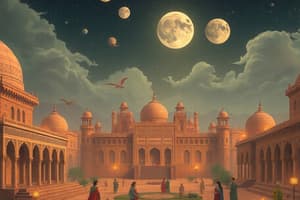Podcast
Questions and Answers
What was a key feature of urban planning in the Indus Civilization that contributed to sanitation?
What was a key feature of urban planning in the Indus Civilization that contributed to sanitation?
- Elevated buildings
- Water drainage systems (correct)
- Underground storage
- Ritual bathing areas
How did the Indus Valley economic and trade systems primarily contribute to its prosperity?
How did the Indus Valley economic and trade systems primarily contribute to its prosperity?
- Through extensive use of currency
- By importing goods from neighboring regions
- Through trade of animal skins and metals (correct)
- By focusing solely on agriculture
In what way did the social structure of the Indus Civilization differ from that of Mesopotamia?
In what way did the social structure of the Indus Civilization differ from that of Mesopotamia?
- It functioned without family units
- It had a defined ruling class
- It was completely egalitarian (correct)
- It was strictly hierarchical
What environmental factors are suggested to have contributed to the decline of the Indus Civilization?
What environmental factors are suggested to have contributed to the decline of the Indus Civilization?
What does the Dancing Girl artifact indicate about the Indus Valley people's values?
What does the Dancing Girl artifact indicate about the Indus Valley people's values?
Which of the following was a significant achievement in urban development noted for the Indus Civilization?
Which of the following was a significant achievement in urban development noted for the Indus Civilization?
Which river was vital in supporting the settlements of the Indus Civilization?
Which river was vital in supporting the settlements of the Indus Civilization?
What societal aspect is indicated by the egalitarian nature of the Indus Civilization?
What societal aspect is indicated by the egalitarian nature of the Indus Civilization?
What does Brahmacharya refer to in the context of Jainism?
What does Brahmacharya refer to in the context of Jainism?
Which Jain sect practices nudity as a sign of renunciation?
Which Jain sect practices nudity as a sign of renunciation?
What significant cultural influence did Jainism have on Indian society?
What significant cultural influence did Jainism have on Indian society?
Which of the following describes Dukkha in Buddhism?
Which of the following describes Dukkha in Buddhism?
What does the Eightfold Path aim to achieve in Buddhism?
What does the Eightfold Path aim to achieve in Buddhism?
Who was the founder of Buddhism?
Who was the founder of Buddhism?
Which of the following is NOT one of the Four Noble Truths?
Which of the following is NOT one of the Four Noble Truths?
What is the significance of the Bodhi tree in Buddhism?
What is the significance of the Bodhi tree in Buddhism?
What indicates a sophisticated level of commerce in the Indus Civilization?
What indicates a sophisticated level of commerce in the Indus Civilization?
What materials did the Indus Civilization primarily work with in metallurgy?
What materials did the Indus Civilization primarily work with in metallurgy?
Which of the following goods is NOT mentioned as being traded by the Indus Civilization?
Which of the following goods is NOT mentioned as being traded by the Indus Civilization?
What aspect of society does the presence of children’s toys suggest about the Indus Civilization?
What aspect of society does the presence of children’s toys suggest about the Indus Civilization?
What does the lack of evidence for monumental palaces in the Indus Civilization suggest about their social structure?
What does the lack of evidence for monumental palaces in the Indus Civilization suggest about their social structure?
How were trade and commerce enhanced in the Indus Civilization?
How were trade and commerce enhanced in the Indus Civilization?
What does the Dancing Girl of Mohenjo-Daro signify about Indus culture?
What does the Dancing Girl of Mohenjo-Daro signify about Indus culture?
Which crop was NOT part of the agricultural practices of the Indus Civilization?
Which crop was NOT part of the agricultural practices of the Indus Civilization?
What is the primary focus of Karma Yoga?
What is the primary focus of Karma Yoga?
Which concept distinguishes the eternal soul from the physical body in Jnana Yoga?
Which concept distinguishes the eternal soul from the physical body in Jnana Yoga?
What lesson does Krishna convey through the idea of the body undergoing changes from childhood to old age?
What lesson does Krishna convey through the idea of the body undergoing changes from childhood to old age?
Which principle of Jainism focuses on the avoidance of harm to all living beings?
Which principle of Jainism focuses on the avoidance of harm to all living beings?
What does Buddhi Yoga encourage individuals to do?
What does Buddhi Yoga encourage individuals to do?
How does Khrisna describe the wise in relation to physical death?
How does Khrisna describe the wise in relation to physical death?
What key aspect of equanimity is emphasized by Krishna?
What key aspect of equanimity is emphasized by Krishna?
What major transformation did Mahavira bring to Jainism?
What major transformation did Mahavira bring to Jainism?
What subjects were taught at Takshashila?
What subjects were taught at Takshashila?
Which scholar is notably associated with Takshashila and is recognized for his work in grammar?
Which scholar is notably associated with Takshashila and is recognized for his work in grammar?
Which language is recognized as the most spoken language in India?
Which language is recognized as the most spoken language in India?
Which statement accurately reflects the academic freedom at Takshashila?
Which statement accurately reflects the academic freedom at Takshashila?
What is the primary script used for writing Hindi?
What is the primary script used for writing Hindi?
What was Kautilya known for in his role as an advisor to Emperor Chandragupta Maurya?
What was Kautilya known for in his role as an advisor to Emperor Chandragupta Maurya?
Which of the following scripts was used in the Gandhara region?
Which of the following scripts was used in the Gandhara region?
What educational contributions did universities like Takshashila make?
What educational contributions did universities like Takshashila make?
Which of the following concepts is central to the Mahabharata?
Which of the following concepts is central to the Mahabharata?
What percentage of the Indian population speaks Hindi?
What percentage of the Indian population speaks Hindi?
Which key teachings are emphasized in Chapter 2 of the Bhagavad Gita?
Which key teachings are emphasized in Chapter 2 of the Bhagavad Gita?
Which script is adapted for Urdu with additional letters for Persian sounds?
Which script is adapted for Urdu with additional letters for Persian sounds?
Which of the following describes the multilingual nature of South Asia?
Which of the following describes the multilingual nature of South Asia?
Which language is NOT mentioned as one of the most spoken languages in India?
Which language is NOT mentioned as one of the most spoken languages in India?
Which script is known for beautiful calligraphy, especially from wealthy courts?
Which script is known for beautiful calligraphy, especially from wealthy courts?
What is common among Indians in relation to language?
What is common among Indians in relation to language?
Flashcards
Indus Civilization Trade
Indus Civilization Trade
The Indus Civilization engaged in long-distance trade with Mesopotamia, exchanging goods such as lapis lazuli, carnelian beads, and pottery.
Standardized Weights/Measures
Standardized Weights/Measures
The Indus people used standardized weights and measures for trade, indicating a well-organized commercial system.
Indus Metallurgy
Indus Metallurgy
Indus people excelled in metalworking, creating items from copper, bronze, lead, and tin, showcasing a high level of technological skill.
Indus Economy
Indus Economy
Signup and view all the flashcards
Indus Social Structure
Indus Social Structure
Signup and view all the flashcards
Indus Art/Artifacts
Indus Art/Artifacts
Signup and view all the flashcards
Indus Family Life
Indus Family Life
Signup and view all the flashcards
Indus Hygiene
Indus Hygiene
Signup and view all the flashcards
Karma Yoga
Karma Yoga
Signup and view all the flashcards
Jnana Yoga
Jnana Yoga
Signup and view all the flashcards
Buddhi Yoga
Buddhi Yoga
Signup and view all the flashcards
Sankhya Yoga
Sankhya Yoga
Signup and view all the flashcards
Arjuna's Surrender
Arjuna's Surrender
Signup and view all the flashcards
Soul's Journey
Soul's Journey
Signup and view all the flashcards
Eternal Soul
Eternal Soul
Signup and view all the flashcards
Equanimity
Equanimity
Signup and view all the flashcards
Indus Valley Urban Planning
Indus Valley Urban Planning
Signup and view all the flashcards
Indus Valley Trade
Indus Valley Trade
Signup and view all the flashcards
Indus Valley Social Structure
Indus Valley Social Structure
Signup and view all the flashcards
Indus Valley Decline
Indus Valley Decline
Signup and view all the flashcards
Indus Valley Artifacts
Indus Valley Artifacts
Signup and view all the flashcards
Great Bath
Great Bath
Signup and view all the flashcards
Indus Valley Hygiene
Indus Valley Hygiene
Signup and view all the flashcards
Egalitarian Society
Egalitarian Society
Signup and view all the flashcards
Brahmacharya
Brahmacharya
Signup and view all the flashcards
Aparigraha
Aparigraha
Signup and view all the flashcards
Jainism's influence on vegetarianism
Jainism's influence on vegetarianism
Signup and view all the flashcards
Jainism's impact on Indian culture
Jainism's impact on Indian culture
Signup and view all the flashcards
Who was Buddha?
Who was Buddha?
Signup and view all the flashcards
Four Noble Truths
Four Noble Truths
Signup and view all the flashcards
Eightfold Path
Eightfold Path
Signup and view all the flashcards
What is Right Action?
What is Right Action?
Signup and view all the flashcards
Takshashila University
Takshashila University
Signup and view all the flashcards
Academic Freedom in Ancient India
Academic Freedom in Ancient India
Signup and view all the flashcards
Kautilya's Pragmatic Ideas
Kautilya's Pragmatic Ideas
Signup and view all the flashcards
Contributions of Ancient Indian Education
Contributions of Ancient Indian Education
Signup and view all the flashcards
Mahabharata's Main Themes
Mahabharata's Main Themes
Signup and view all the flashcards
The Bhagavad Gita's Central Teachings
The Bhagavad Gita's Central Teachings
Signup and view all the flashcards
Key Distinctions in Jainism
Key Distinctions in Jainism
Signup and view all the flashcards
Buddhism's Core Teachings
Buddhism's Core Teachings
Signup and view all the flashcards
Official Languages of South Asia
Official Languages of South Asia
Signup and view all the flashcards
Indus Valley Script
Indus Valley Script
Signup and view all the flashcards
Kharosthi Script
Kharosthi Script
Signup and view all the flashcards
Brahmi Script
Brahmi Script
Signup and view all the flashcards
Devanagari Script
Devanagari Script
Signup and view all the flashcards
Perso-Arabic Script
Perso-Arabic Script
Signup and view all the flashcards
Roman Script in South Asia
Roman Script in South Asia
Signup and view all the flashcards
Bilingualism in South Asia
Bilingualism in South Asia
Signup and view all the flashcards
Study Notes
Indus Civilization (3300-1300 BCE)
- The Indus Civilization, also known as the Harappan Civilization, was one of the world's earliest urban cultures
- Located in Pakistan and northwest India, covering 1,000,000 square kilometers
- Major urban sites included Harappa, Mohenjo-Daro, Lothal, and Rakhigarhi
- Approximately 1,022 cities and settlements, 406 in Pakistan and 616 in India
- Settlements ranged from small villages to large urban centers
Timeline
- Early Phase (3300-2600 BCE): Agricultural practices developed, and early villages emerged
- Mature Phase (2600-1900 BCE): Peak period with urban centers, trade, and advanced technology
- Late Phase (1900-1300 BCE): Decline in settlements and shift towards smaller settlements
Urban Planning and Technology
- Urban Planning: Sophisticated grid planning in cities like Harappa and Mohenjo-Daro
- Well-organized streets, wide avenues, and narrower lanes for residential areas
- Advanced drainage system with covered drains for wastewater management
- Public infrastructure like the Great Bath (Mohenjo-Daro) for ritual purposes, granaries for food storage, and assembly halls for public gatherings
- Technological Advancements: Skilled craftsmen known for carnelian beads, pottery, and seal carvings
- Motifs used for trade and identification purposes
Studying That Suits You
Use AI to generate personalized quizzes and flashcards to suit your learning preferences.




